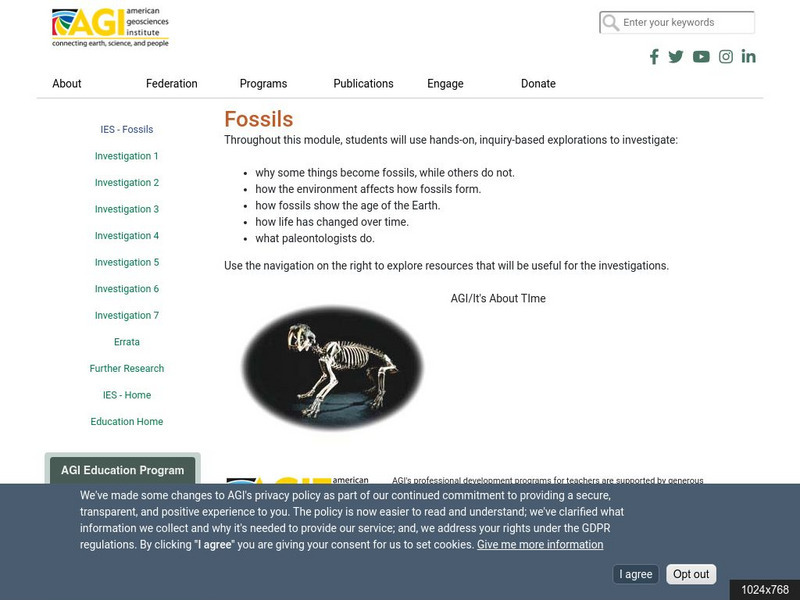Hi, what do you want to do?
Curated OER
Water and Ice
Pupils explore water as it changes states of matter. In this physical property lesson, students use observation, measurement, and communication skills to describe changes in water as it goes from a solid to a liquid and back again.
Curated OER
Plugged in to CO2
Young scholars use a meter to measure the energy used and carbon produced by electronics and appliances. In this environmental science and technology lesson, students use a Kill-A-Watt meter to determine the electricity used by everyday...
Curated OER
Important, Interesting and Serious Exercise
In this word usage worksheet, students explore the meanings of three words, important, interesting, and serious. Students complete fifteen sentences with the correct words and write four sentences of their own.
Curated OER
Human Prehistory
Students discuss the history of humans. For this human history lesson, students describe how the placement of the continents changed and where the humans began and traveled to. They discuss interaction with Neanderthals and...
Curated OER
Important, Interesting, and Serious Exercise
In this word usage worksheet, students read the sentences and fill in the gaps with the words important, interesting, and serious to complete the 15 exercises.
Curated OER
Dogs & Darwin
Ninth graders construct and conduct a laboratory experiment illustrating the transfer of mutations. They compare and contrast natural selection in organisms with long and short reproductive cycles.
Alabama Learning Exchange
Botany Scavenger Hunt Where's the Ginkgo?
Learners use a science journal to log plants that are native to Alabama. In this plant lesson plan, students identify characteristics, describe environments, and classify the plants that they find.
Curated OER
WorldWatcher Activity: Investigating Population and Carbon Emissions
Young scholars develop a population density visualization chart to begin the instructional activity. In groups, they use this information to compare to rates of carbon emissions for their country. They identify solutions to the problem...
Curated OER
Human Evolution
High schoolers make and use observations of Laetoli footprints to provide clues to life in the past. They collect and analyze data to study the relationship between foot length and body height.
Curated OER
Ambush Warriors
Students identify four different categories of reptiles and explain how snakes deliver their venom to their prey.
Curated OER
Curious About Creepy Crawlies?
Pupils create oral presentations and visual aids to assist their inquiry about various insects. They reflect on the importance of learning about insects while working in small groups.
Curated OER
People Changing the Atmosphere Lab
Young scholars examine ways to reduce the greenhouse effect. Students keep a "CO2 Journal" to help establish a connection between their own behavior and its impact on global warming as well as discover ways to reduce global warming.
Curated OER
Birds of Different Feathers: Species Specialization
Students identify differences in bird species and explain the concept of species specialization. They attain the knowledge that different birds occupy different habitats.
Students identify characteristics and features of birds that make...
Curated OER
Law of Superposition
Students identify the law of superposition and it states that beds of rock in a series are laid down with the oldest at the bottom and younger layers on the top. They construct a legen for a block diagram and construct a block diagram...
Curated OER
What came first?
Students sequence events in their own lives and assign each a numerical time, students use the same process to sequence actual events in the evolution of life on Earth.
Curated OER
Biology: Natural Selection
Students explore evolutionary processes and theories using the spotted fish applet. They observe what happens to fish in a closed environment with both food and predators. Students run the model several times and answer questions about...
Curated OER
Why do we need Vitamin C in our diet? Or Why do we carry old inactive genes in our genome?
Students explore and explain how mutations in the DNA sequence of a gene may be silent or result in phenotypic change in an organism and in its offspring. They analyze how evolution and biodiversity are the result of genetic changes that...
Curated OER
Superbugs and Antibiotic Resistance
Students complete experiments on antibiotics and antimicrobials. In groups, they explain how antibiotics affect the evolution of microorganisms. They test various types of bacteria to discover how much resistance they have to antibiotics.
Curated OER
Biology Chapter 15 Word Search Puzzle
In this biology worksheet, middle schoolers look for the words that are related to the theme of the worksheet. They also work on the skills of spelling and word recognition.
Curated OER
Breaking News English: The Year 2007 to be the Hottest Ever
In this English worksheet, students read "The Year 2007 to be the Hottest Ever," and then respond to 47 fill in the blank, 7 short answer, 20 matching, and 8 true or false questions about the selection.
American Geosciences Institute
American Geosciences Institute: Fossils
Seven hands-on lessons module where students learn about fossils. These inquiry-based investigations explore how fossils form, properties of fossils, comparing fossils, how they show the age of the Earth, and what paleontologists do.
University of California
University of California Museum of Paleontology: Stories From the Fossil Record
This colorful, interactive site demonstrates how fossils can be used to discover a range of information about the past. Topics include Past Lives, Paleoecology, Geologic History, and Biodiversity.
Indiana University
Indiana University Bloomington: Identifying 3 D Fossil Prints [Pdf]
In this lesson, learners will identify three-dimensional (3-D) prints of common Indiana fossils to the kingdom, phylum, or class level. Students will observe and record the morphology of specimens and classify organisms based on their...
University of California
Ucmp: Getting Into the Fossil Record
A learning module where students tour the fossil record to learn what fossils are, how organisms become fossils, the factors that promote fossilization, how paleontologists find fossils, and why some organisms cannot be fossilized....


























![Indiana University Bloomington: Identifying 3 D Fossil Prints [Pdf] Lesson Plan Indiana University Bloomington: Identifying 3 D Fossil Prints [Pdf] Lesson Plan](https://static.lp.lexp.cloud/images/attachment_defaults/resource/large/FPO-knovation.png)
